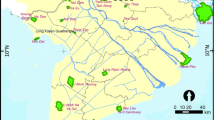Abstract
The lower Colorado River mainstem and delta have been severely damaged by a variety of human-related activities, including river impoundment, agriculture, water diversions, introduction of exotic plants and fishes, and ground-water pumping. In some areas, the native wetland habitat that formerly dominated this region has disappeared completely. Nevertheless, there are areas where significant wetland habitat persists as a result of incidental circumstances or purposeful restoration actions. These areas provide important conservation and restoration opportunities. In this investigation, nine restoration efforts along the lower Colorado River from Parker Dam to the delta region were evaluated to learn how lessons from these experiences can benefit future ecological restoration efforts. In addition, we assessed the general ecological condition of this reach to identify critical native wetland plant communities and recommend strategies for protecting these areas in the future. It is apparent that wetland ecosystems in both the delta and the mainstem would benefit if effluent waters were allocated to support wetlands rather than allocated to evaporative basins. Other important strategies for improving the ecological condition of the river should include altering reservoir releases, improving the effectiveness of revegetation efforts, and developing bi-national, collaborative approaches involving local communities and landowners to identify and carry out projects that benefit both them and the ecological condition of the river.
Similar content being viewed by others
Literature Cited
Abarca, F.J., M.F. Ingraldi, and A. Varela-Romero 1993. Observations on the desert pupfish (Cyprinodon macularjus). Yuma clapper rail (Rallus longirostris yumanensis) and shorebird communities in the Ciénega de Santa Clara, Sonora, México. Nongame and Endangered Wildlife Program Technical Report. Arizona Game and Fish Department, Phoenix, AZ, USA.
Alvarez de Williams, A. 1978. Southwest Cocopah. p. 99–113.In A. Ortiz (ed.) Handbook of North American Indians, vol. 10. Smithsonian Institution, Washington, DC, USA.
Anderson, B.W. 1989. Research as an integral part of revegetation projects. p. 419–423.In D.L. Abell (tech. coor.) Proceedings of the California Riparian Systems Conference: Protection, Management, and Restoration for the 1990s. U.S. Department of Agriculture/Forest Service General Technical Report/PSW-110.
Anderson, B.W., R.D. Ohmart, and H.A. Allen, Jr. 1984. Riparian birds in the riparian/agricultural interface. p. 190–195.In R.E. Warner and K.M. Hendrix (eds.) California Riparian Systems. University of California Press, Berkeley, CA, USA.
Briggs, M.K. 1996. Riparian Ecosystem Recovery in Arid Lands. University of Arizona Press, Tucson, AZ, USA.
Cisneros-Mata, M., G. Montemayor-Lopez, and M. Roman-Rodrequez. 1995. Life history and conservation ofTotaba macdonaldi. Conservation Biology 9:806–814.
Colorado River Basin Salinity Control Forum. 1990. Water quality standards for salinity Colorado River system. 106 West 500 South. Suite 101, Bountiful, UT, USA 84010.
Eddleman, W.R. 1989. Biology of the Yuma Clapper Rail in the southwestern U.S. and northwestern México. U.S. Bureau of Reclamation, Yuma Projects Office. Yuma, AZ, USA.
Glenn, E.P., C. Congdon, and J. Garcia. 1997. New value for old water. World and I April 1997:204–211.
Glenn, E.P., C. Lee, R. Felger, and S. Zengel. 1996. Effects of water management on the wetlands of the Colorado River delta. Mexico. Conservation Biology 10:1175–1186.
Glenn, E.P., R.S. Felger, A. Burquez, and D.S. Turner. 1992. Ciénega de Santa Clara: endangered wetland in the Colorado River delta, Sonora, México. Natural Resources Journal 32:817–824.
Hendrickson, D.A. and A. Varela-Romero. 1989. Conservation status of the desert pupfish,Cyprinodon macularius, in México and Arizona. Copeia 1989:478–483.
Lee, C.T. 1994. Mapping wetland dynamics in the lower Colorado River delta using archival landsat map satellite imagery. Arizona Remote Sensing Center, Office of Arid Lands Studies, University of Arizona, Tucson, AZ, USA.
McDougal, D.T. 1904. Delta and delta vegetation. Botanical Gazette 38:44–63.
Minckley, W.L. 1991. Native fishes of the Grand Canyon Region: An Obituary? p. 124–177.In Colorado River Ecology and Dam Management. National Academy Press, Washington, DC, USA.
Morales-Abril, G. 1994. Reserva de la Biosfera Alto Golfo de California y delta del Río Colorado. Ecologica 3:26–27.
Morrison, J.I., S.L. Postel, and P.H. Gleick. 1996. The sustainable use of water in the lower Colorado River basin. Pacific Institute and Global Water Policy Project, 1204 Preservation Park Way, Oakland, CA, USA.
Nimkin, D. 1996. Sustainable development opportunities in the Arizona-Sonora borderlands. Unpublished report prepared by David Nimkin for the Sonoran Institute, Tueson, Arizona.
Ohmart, D. R., W.O. Deason, and C. Burke. 1977. A riparian case history: the Colorado River. p. 35–47.In R.R. Johnson and D.A. Jones (tech. coor.) Preservation and Management of Riparian Habitat: A Symposium, U.S. Department of Agriculture/Forest Service General Technical Report/RM-43.
Payne, J.M., F.A. Reid, and E.C. Gonzalez. 1992. Feasibility study for the possible enhancement of the Colorado River delta wetlands, Baja California Norte, México. Report to Ducks Unlimited, Inc., and Ducks-Unlimited of México, Sacramento, CA, USA.
Pinkney, F.C. 1992. Revegetation and enhancement of riparian communities along the lower Colorado River. U.S. Department of the Interior, Bureau of Reclamation, Ecological Resources Branch, Ecological Resources Division, Denver, CO, USA.
Pontius, D. Colorado River Basin study. 1997. Report to the Western Water Policy Review Advisory Commission. National Technical Information Service, Springfield, VA, USA.
Sykcs, G. 1937. The Colorado River delta. Carnegie Institution of Washington, DC. USA. Publication no. 460.
Thompson, R.W. 1968. Tidal flat sedimentation on the Colorado River delta, northwestern Galf of California. Geological Society of America, Boulder, CO, USA. Memoir 107.
Zengel, S.A., V.J. Meretsky, E.P. Glenn, R.S. Felger, and D. Ortiz. 1995. Cienega de Santa Clara, a remnant wetland in the Río Colorado delta (México): vegetation distribution and the effects of water flow reduction. Ecological Engineering 4:19–36.
Author information
Authors and Affiliations
Rights and permissions
About this article
Cite this article
Briggs, M.K., Cornelius, S. Opportunities for ecological improvement along the lower Colorado River and delta. Wetlands 18, 513–529 (1998). https://doi.org/10.1007/BF03161669
Received:
Revised:
Accepted:
Issue Date:
DOI: https://doi.org/10.1007/BF03161669




